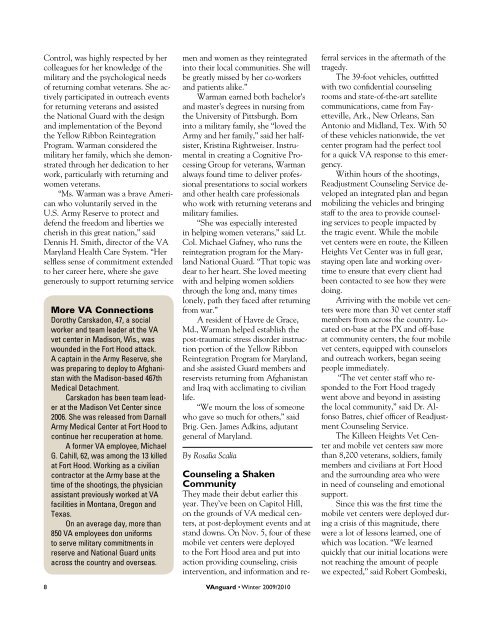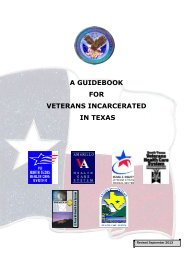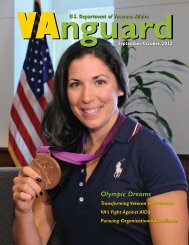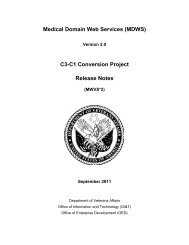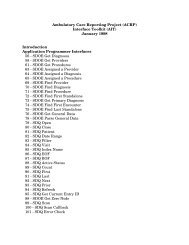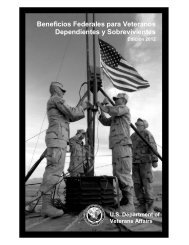Wounded ounded Warrior arrior Car ee - US Department of ...
Wounded ounded Warrior arrior Car ee - US Department of ...
Wounded ounded Warrior arrior Car ee - US Department of ...
Create successful ePaper yourself
Turn your PDF publications into a flip-book with our unique Google optimized e-Paper software.
Control, was highly respected by her<br />
colleagues for her knowledge <strong>of</strong> the<br />
military and the psychological n<strong>ee</strong>ds<br />
<strong>of</strong> returning combat veterans. She actively<br />
participated in outreach events<br />
for returning veterans and assisted<br />
the National Guard with the design<br />
and implementation <strong>of</strong> the Beyond<br />
the Yellow Ribbon Reintegration<br />
Program. Warman considered the<br />
military her family, which she demonstrated<br />
through her dedication to her<br />
work, particularly with returning and<br />
women veterans.<br />
“Ms. Warman was a brave American<br />
who voluntarily served in the<br />
U.S. Army Reserve to protect and<br />
defend the fr<strong>ee</strong>dom and liberties we<br />
cherish in this great nation,” said<br />
Dennis H. Smith, director <strong>of</strong> the VA<br />
Maryland Health <strong>Car</strong>e System. “Her<br />
selfess sense <strong>of</strong> commitment extended<br />
to her car<strong>ee</strong>r here, where she gave<br />
generously to support returning service<br />
8<br />
More VA Connections<br />
Dorothy carskadon, 47, a social<br />
worker and team leader at the Va<br />
vet center in madison, Wis., was<br />
w<strong>ounded</strong> in the fort Hood attack.<br />
a captain in the army reserve, she<br />
was preparing to deploy to afghanistan<br />
with the madison-based 467th<br />
medical Detachment.<br />
carskadon has b<strong>ee</strong>n team leader<br />
at the madison Vet center since<br />
2006. she was released from Darnall<br />
army medical center at fort Hood to<br />
continue her recuperation at home.<br />
a former Va employ<strong>ee</strong>, michael<br />
g. cahill, 62, was among the 13 killed<br />
at fort Hood. Working as a civilian<br />
contractor at the army base at the<br />
time <strong>of</strong> the shootings, the physician<br />
assistant previously worked at Va<br />
facilities in montana, oregon and<br />
texas.<br />
on an average day, more than<br />
850 Va employ<strong>ee</strong>s don uniforms<br />
to serve military commitments in<br />
reserve and National guard units<br />
across the country and overseas.<br />
men and women as they reintegrated<br />
into their local communities. She will<br />
be greatly missed by her co-workers<br />
and patients alike.”<br />
Warman earned both bachelor’s<br />
and master’s degr<strong>ee</strong>s in nursing from<br />
the University <strong>of</strong> Pittsburgh. Born<br />
into a military family, she “loved the<br />
Army and her family,” said her halfsister,<br />
Kristina Rightweiser. Instrumental<br />
in creating a Cognitive Processing<br />
Group for veterans, Warman<br />
always found time to deliver pr<strong>of</strong>essional<br />
presentations to social workers<br />
and other health care pr<strong>of</strong>essionals<br />
who work with returning veterans and<br />
military families.<br />
“She was especially interested<br />
in helping women veterans,” said Lt.<br />
Col. Michael Gafney, who runs the<br />
reintegration program for the Maryland<br />
National Guard. “That topic was<br />
dear to her heart. She loved m<strong>ee</strong>ting<br />
with and helping women soldiers<br />
through the long and, many times<br />
lonely, path they faced after returning<br />
from war.”<br />
A resident <strong>of</strong> Havre de Grace,<br />
Md., Warman helped establish the<br />
post-traumatic stress disorder instruction<br />
portion <strong>of</strong> the Yellow Ribbon<br />
Reintegration Program for Maryland,<br />
and she assisted Guard members and<br />
reservists returning from Afghanistan<br />
and Iraq with acclimating to civilian<br />
life.<br />
“We mourn the loss <strong>of</strong> someone<br />
who gave so much for others,” said<br />
Brig. Gen. James Adkins, adjutant<br />
general <strong>of</strong> Maryland.<br />
By Rosalia Scalia<br />
Counseling a Shaken<br />
Community<br />
They made their debut earlier this<br />
year. They’ve b<strong>ee</strong>n on Capitol Hill,<br />
on the grounds <strong>of</strong> VA medical centers,<br />
at post-deployment events and at<br />
stand downs. On Nov. 5, four <strong>of</strong> these<br />
mobile vet centers were deployed<br />
to the Fort Hood area and put into<br />
action providing counseling, crisis<br />
intervention, and information and re<br />
VAnguard • Winter 2009/2010<br />
ferral services in the aftermath <strong>of</strong> the<br />
tragedy.<br />
The 39-foot vehicles, outftted<br />
with two confdential counseling<br />
rooms and state-<strong>of</strong>-the-art satellite<br />
communications, came from Fayetteville,<br />
Ark., New Orleans, San<br />
Antonio and Midland, Tex. With 50<br />
<strong>of</strong> these vehicles nationwide, the vet<br />
center program had the perfect tool<br />
for a quick VA response to this emergency.<br />
Within hours <strong>of</strong> the shootings,<br />
Readjustment Counseling Service developed<br />
an integrated plan and began<br />
mobilizing the vehicles and bringing<br />
staff to the area to provide counseling<br />
services to people impacted by<br />
the tragic event. While the mobile<br />
vet centers were en route, the Kill<strong>ee</strong>n<br />
Heights Vet Center was in full gear,<br />
staying open late and working overtime<br />
to ensure that every client had<br />
b<strong>ee</strong>n contacted to s<strong>ee</strong> how they were<br />
doing.<br />
Arriving with the mobile vet centers<br />
were more than 30 vet center staff<br />
members from across the country. Located<br />
on-base at the PX and <strong>of</strong>f-base<br />
at community centers, the four mobile<br />
vet centers, equipped with counselors<br />
and outreach workers, began s<strong>ee</strong>ing<br />
people immediately.<br />
“The vet center staff who responded<br />
to the Fort Hood tragedy<br />
went above and beyond in assisting<br />
the local community,” said Dr. Alfonso<br />
Batres, chief <strong>of</strong>fcer <strong>of</strong> Readjustment<br />
Counseling Service.<br />
The Kill<strong>ee</strong>n Heights Vet Center<br />
and mobile vet centers saw more<br />
than 8,200 veterans, soldiers, family<br />
members and civilians at Fort Hood<br />
and the surrounding area who were<br />
in n<strong>ee</strong>d <strong>of</strong> counseling and emotional<br />
support.<br />
Since this was the frst time the<br />
mobile vet centers were deployed during<br />
a crisis <strong>of</strong> this magnitude, there<br />
were a lot <strong>of</strong> lessons learned, one <strong>of</strong><br />
which was location. “We learned<br />
quickly that our initial locations were<br />
not reaching the amount <strong>of</strong> people<br />
we expected,” said Robert Gombeski,


